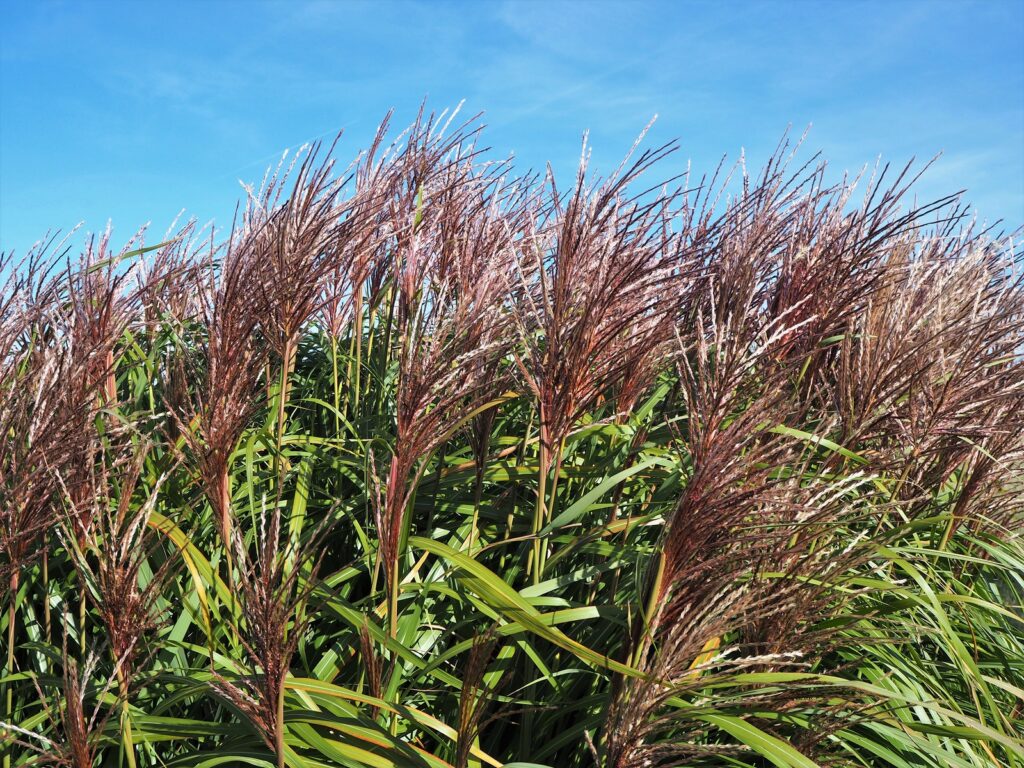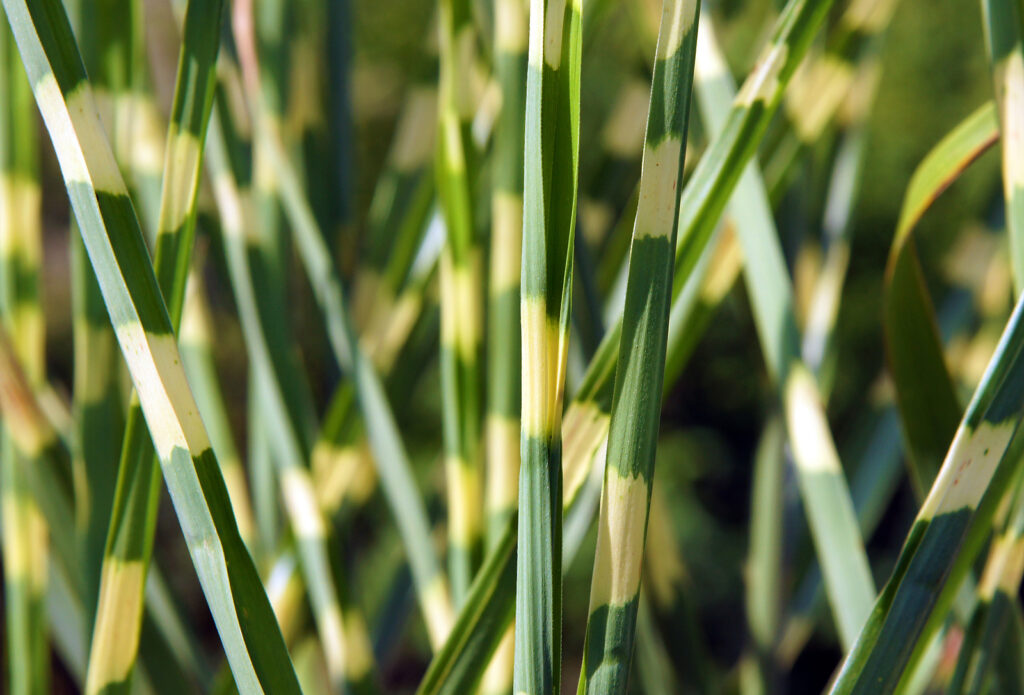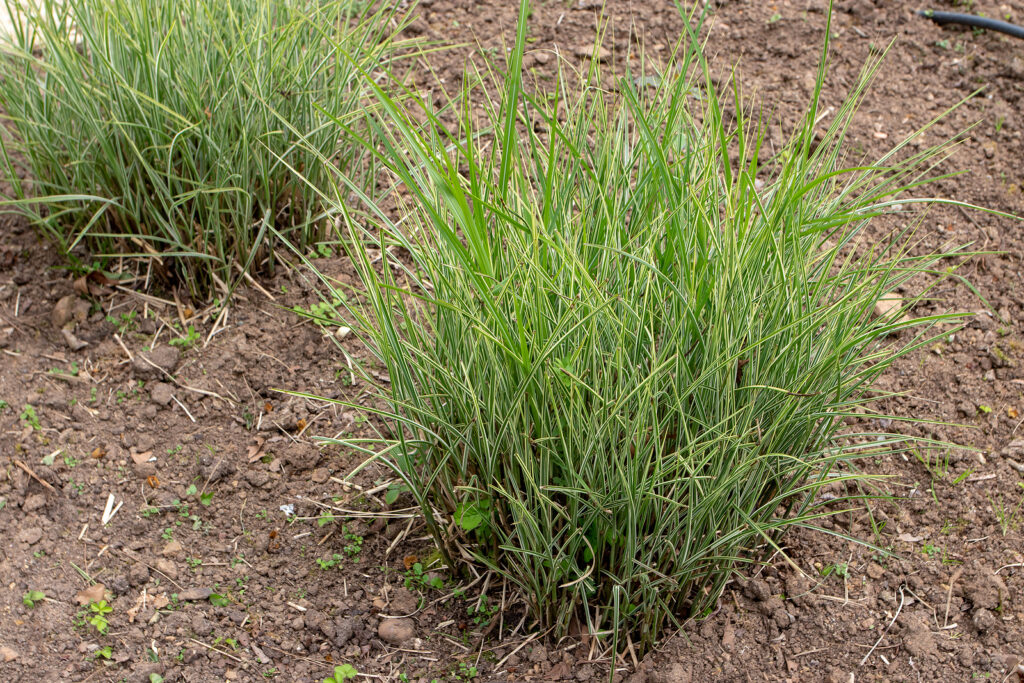Miscanthus – commonly called Eulalia grass, silver grass, or maiden grass–is a large clump-forming grass that bears attractive flower clusters that open as tassels and gradually expand into large plumes atop tall stalks in late summer and fall. Flower plumes are silvery to pinkish or bronze and last well into winter.
Miscanthus foliage can be narrow, solid-colored, striped lengthwise, or banded. the graceful green leaves turn to shades of yellow, orange, or reddish-brown in autumn and winter.
Miscanthus can be grown as a free-standing specimen or added to a mixed or herbaceous border. It can be added to waterside plantings or used as a temporary summer screen. The flower heads can be used for cutting or drying.
Miscanthus is a genus of about 20 species of deciduous or evergreen, tufted, or rhizomatous perennials. Miscanthus is native to moist meadows and marshlands from Africa to East Asia.

Get to know Miscanthus
- Plant type: Perennial grass
- Growing zones and range: Zones 4 to 9
- Hardiness: Hardy to Zone 4
- Height and width: Varies, to 12 feet (4m) tall, spreading 6 feet (2m) across
- Growth rate: Slow
- Form and habit: Clump-forming grass
- Foliage: Reed-like stems bear linear or narrowly lance-shaped, folded, arching, light or mid-green, or blue- or purplish-green leaves
- Flowers: Dense, terminal, arching panicles of silky-hairy spikelets; flowerheads are more numerous following long, hot summers
- Bloom time: Late summer and autumn
- Uses: Specimens, mixed, or herbaceous border, waterside planting, temporary screening, add color to winter landscape
- Common name: Eulalia grass, Silver grass, Maiden grass
- Botanical name: Miscanthus
- Family name: Poaceae
- Origin: Africa to eastern Asia
Where to plant Miscanthus
- Plant Miscanthus in full sun; Miscanthus will flop in shade.
- Plant Miscanthus in moderately fertile, moist but well-drained soil.
- Protect Miscanthus from excessive winter moisture.
When to plant Miscanthus
- Set contaner-grown Miscanthus in the garden in spring or autumn.
- Sow Miscanthus seed in containers in a cold frame in early spring.
- Miscanthus may be slow to establish; pot on divisions or grow in a cold frame or cold or cool greenhouse until established.

Planting and spacing Miscanthus
- Give Miscanthus plenty of room at planting time, as mature clumps can be 6 feet (2m) or more across.
How to water and feed Miscanthus
- Give Miscanthus much to moderate water.
- Feed Macleaya with an all-purpose organic fertilizer in spring.
How to care for Miscanthus
- Where withered stems are left for winter effect, they should be cut to the ground by early spring.
- Miscanthus need little care.
- Long sleeves and gloves are advisable when working around these plants.
Miscanthus pests and diseases
- Pests and diseases are infrequent.

Miscanthus propagation
- Divide Miscanthus as new growth commences in spring; old clumps become woody and difficult to divide.
Miscanthus varieties to grow
- Miscanthus floridulus (M. giganteus), Amur silvergrass, Giant Chinese silvergrass, deciduous or evergreen, slowly spreading, clump-forming, perennial grass with sturdy, upright stems and downward-arching, linear, glaucous, pale green leaves, to 36 inches (90cm) long, with silver midribs. Erect, pyramidal panicles, to 20 inches (50cm) long, of silvery spikelets, are produced in autumn, although these are rarely borne in cooler regions. Often confused with M. sacchariflorus. To 9 feet (2.5m) tall and 5 feet (1.5m) wide or more. Southeast Asia.
- M. sacchariflorus, Silver banner grass, deciduous, robust, clump-forming, perennial grass bearing stiff, flat, linear, blue-green leaves, to 36 inches (90cm) long, with pale, silver-green midribs. In late summer and early autumn, produces finely hairy, pyramidal or fan-shaped panicles, to 16 inches (40cm) long, of numerous silky-hairy, silvery white spikelets. To 5-7 feet (1.5-2.2m) tall and 4.5 feet (1.4m) wide. Southeast Asia.
- M. sinensis, Eulalia grass, deciduous, clump-forming, perennial grass with erect stems and mostly basal, flat, erect or arching, linear, blue-green leaves, to 4 feet (1.2m) long. Pyramidal panicles, to 16 inches (40cm) long, of silky-hairy, pale gray spikelets, tinted maroon or purple-brown, are produced in autumn. To 12 feet (4m) tall and 4 feet (1.2m) wide. Southeast Asia.
- M. yakushimensis, dense, clump-forming, deciduous, perennial grass with narrowly linear leaves, to 24 inches (60cm) long; leaves are light green, with silvery pink midribs, and turn yellow in autumn. Slender, open, conical or fan-shaped silvery panicles, to 20 inches (50cm) long, are produced in late summer and early autumn. To 24-30 inches (60-75cm) tall and 30 inches (75cm) wide. Japan.















